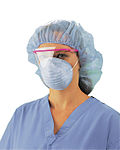AY Honors/Home Nursing/Answer Key
Infection control and health care epidemiology is the discipline concerned with preventing the spread of infections within the health-care setting. As such, it is a practical (rather than an academic) sub-discipline of epidemiology. It is an essential (though often underrecognized and undersupported) part of the infrastructure of health care. Infection control and hospital epidemiology are akin to public health practice, practiced within the confines of a particular health-care delivery system rather than directed at society as a whole.
Infection control concerns itself both with prevention (hand hygiene/hand washing, cleaning/disinfection/sterilization, vaccination, surveillance) and with investigation and management of demonstrated or suspected spread of infection within a particular health-care setting (e.g. outbreak investigation).
Prevention of Infection in the Health Care setting
Hand Hygiene
Independent studies by Ignaz Semmelweis in 1847 in Vienna and Oliver Wendell Holmes in 1843 in Boston established a link between the hands of health care workers and the spread of hospital-acquired disease.& The Centers for Disease Control and Prevention (CDC) has stated that “It is well-documented that the most important measure for preventing the spread of of pathogens is effective handwashing.” & Hand washing is a mandatory requirement in most health care settings and required by many different state and local regulations as well as good sense.
Occupational Safety and Health Administration (OSHA) standards& require that employers must provide readily accessible hand washing facilities, and must ensure that employees wash hands and any other skin with soap and water or flush mucous membranes with water as soon as feasible after contact with blood or other potentially infectious materials (OPIM).
Cleaning, disinfection and sterilization (microbiology)
Personal Protective Equipment (PPE)
Personal protective equipment (PPE) is specialized clothing or equipment worn by a worker for protection against a hazard. The hazard in a health care setting is exposure to blood, saliva, or other bodily fluids or aerosols that may carry infectious materials such as Hepatitis C, HIV, or other blood borne or bodily fluid pathogen. PPE prevents contact with a potentially infectious material by creating a physical barrier between the potential infectious material and the healthcare worker.
The Occupational Safety and Health Administration (OSHA) requires the use of Personal protective equipment (PPE) by workers to guard against blood borne pathogens if there is a reasonably anticipated exposure to blood or other potentially infectious materials. &
Components of Personal protective equipment (PPE) include gloves, gowns, bonnets, shoe covers, face shields, CPR masks, goggles, surgical masks, and respirators. How many components are used and how the components are used is often determined by regulations or the infection control protocol of the facility in question. Many or most of these items are disposable to avoid carrying infectious materials from one patient to another patient and to avoid difficult or costly disinfection. OSHA requires the immediate removal and disinfection or disposal of worker's PPE prior to leaving the work area.&
Vaccination of health care workers
Certain diseases have vaccines that give some protection to workers in a healthcare setting. Depending on regulation, recommendation, the specific work function, or personal preference, healthcare workers or first responders may receive vaccinations for hepatitis B; influenza; measles, mumps and rubella; Tetanus, diphtheria, pertussis; N. meningitidis; and varicella. In general, vaccines do not guarantee complete protection from disease, and there is potential for adverse effects from receiving the vaccine. &
Surveillance for emerging infections
Outbreak investigation
Antibiotics are a common treatment when an outbreak occurs. However, if the infection has built a resistance to a particular antibiotic, then that antibiotic would be ineffective. Resistances are 'bred' into an organism as a result of consistent exposure to an antibiotic. Overuse of antibiotics is therefore to be avoided in the interest of public health.
Training in infection control and health care epidemiology
Practitioners can come from several different educational streams. Many begin as nurses, some as medical technologists (particularly in clinical microbiology), and some as physicians (typically infectious disease specialists). Specialized training in infection control and health care epidemiology are offered by the professional organizations described below. Physicians who desire to become infection control practitioners often are trained in the context of an infectious disease fellowship.
Certification Board of Infection Control and Epidemiology is an organization that certifies infection control practitioners based on their educational background and professional experience, in conjunction with testing their knowledge base with standardized exams. The credential awarded is CIC, Certification in Infection Control and Epidemiology.
A course in hospital epidemiology (infection control in the hospital setting) is offered jointly each year by the Centers for Disease Control and Prevention (CDC) and the Society for Healthcare Epidemiology of America.
Footnotes
Professional organizations
Association of Professionals in Infection Control and Epidemiology is primarily composed of infection prevention and control professionals with nursing or medical technology backgrounds
The Society for Healthcare Epidemiology of America is more heavily weighted towards practitioners who are physicians or doctoral-level epidemiologists.

